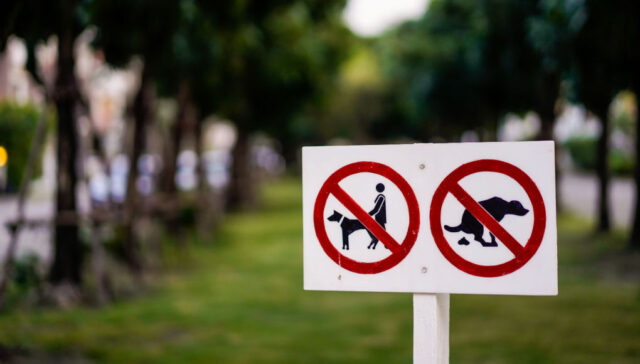
Table of Contents
If you’ve been thinking of visiting a dog park to socialize your dog, it’s high time.
The weather is still significant in springtime in the United States, and the flowers bloom with grace and vigor.
Not only will you be able to interact with numerous other dog enthusiasts, but your furry friend will also get to interact with other pets in a safe and fenced area, play, run, relish in the scent of nature, and explore the great outdoors.
The truth is the exposure provided through dog parks plays an integral role in a dog’s growth and development.
Yet, specific rules and regulations are enforced by park authorities to ensure public safety and security.
From dogs required to be on leashes to respect on the part of the owners, everyone plays an equal role in contributing to a safe dog park environment.
Here, we have compiled a list of dog park rules and regulations you must remember while visiting.
It’ll help maintain peace and order and make you feel secure while having a favorable time with your dog-mate.
Dog Park Rules and Regulations: Safety Rules for Dogs
Visiting a park with your furry friend has numerous benefits. They provide a wonderful socialization opportunity, exercise, stimulation, etc.
One significant reason that often goes unnoticed is the safety dog parks offer by setting up rules and regulations to ensure no party is harmed.
As a pet parent, you are responsible for ensuring your pet is not a threat to those around it.
Here, we have compiled a list of dog safety rules that dogs and owners must abide by before their entry and during their stay at the park.
These include:
Vaccinations and Licenses
Vaccinations are an integral part of dog health.
An unvaccinated dog is at an increased risk of numerous health concerns, including rabies, distemper, parvovirus, and kennel cough.
This is why most dog parks have a strict policy for only permitting dogs that have been given recently given medicated shots to go inside.
You must show proof of vaccination to the park authorities to be permitted inside.
Secondly, a dog license—legal registration derived from the local government—must be shown to the authorities upon arrival.
These show your proof of ownership and also assist in helping you reunite with your dog in case they are lost in the vast expanse of the dog park.
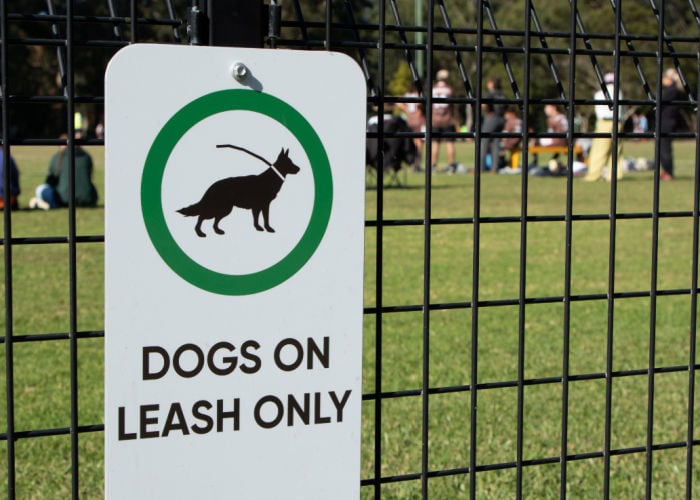
Supervision and Control
Dogs are naturally innately curious and territorial, which may pose a conflict if left unsupervised.
They may clash and try to harm each other if the situation is not resolved.
Dog parks emphasize the need for consistent monitoring to ensure no problems occur in the first place.
This includes always keeping your dog on a leash unless they’re in an off-leash park.
You may also look for any signs of aggression, such as growling, bared teeth, stiff body posture, snapping or biting, etc.
Observe their body language closely and take immediate action if the situation deteriorates.
Most dog parks offer stunning scenery, which may calm our nerves and distract us from looking after our pets.
While it may be enjoyable to look around, it’s also important to keep a close eye on our furry friends, who may dissolve chaos if not guided when required.
Behavior and Aggression
Your pet and its behavior will be your responsibility as you arrive at the park.
This means since you're familiar with your dog's tendencies and instincts, you make an informed decision that complies with the great good.
For example, if you know your pet has a family history of severe aggression passed down to your dog through heredity, it would be in the public's welfare not to bring such a pet to a social place.
Secondly, in-depth understanding and familiarity with your pet's body language is always a perk.
For example, a stiff body posture, fixed stare, or snarling at another dog may signify your pet viewing it as a potential threat.
Alternatively, a loose, relaxed body, wagging tool, and soft and inviting gaze may signify friendliness.
In essence, knowing your dog's cues will help you understand what they need.
This will allow you to make an informed and early decision before it can escalate into behaviors harmful to other individuals and animals.
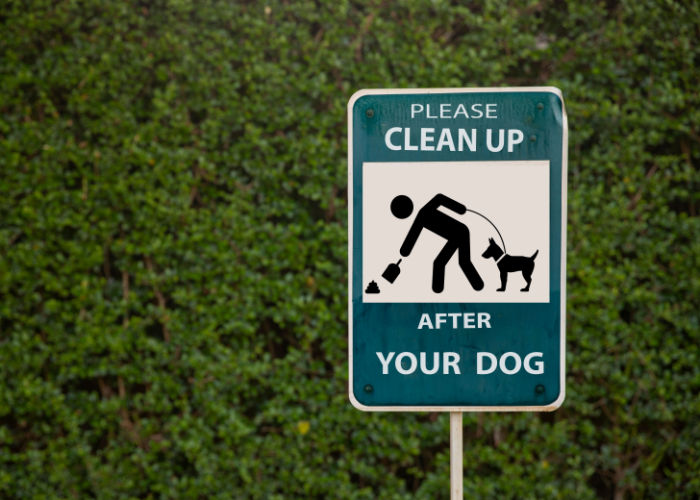
Waste Disposal
The cleaner a park is, the better it will be to explore.
No one wants to go to an unclean park that is not kept well.
Most dog parks maintain strict laws on waste disposal to maintain a healthy and neat environment.
Dog owners must clean up after their dogs promptly and dispose of the waste in designated dustbins.
In addition, it is recommended to bring ample poop bags from home if they are unavailable at the park.
Dirtying the park may result in penalties or being permanently banned from the dog park.
General Etiquette Guidelines
Most dog parks have a list of general etiquette guidelines to ensure the safety and well-being of the visitors.
They aim to manage signs of problematic behavior, such as aggression, barking, and bullying, so everyone can socialize without worrying about their welfare.
They achieve this goal by giving the owners clear expectations of what they deem acceptable or unacceptable.
It’s important to read the principles of the park you intend to visit, as individual differences may exist to maintain order.
Here we have compiled a list of common etiquette most parks enforce to maintain peace.
It is important to remember that non-compliance may result in penalties for the owner, depending on the severity of the violation.
The higher the standards, the better the dog park environment is likely to be.
So, let’s learn about dog park etiquette to ensure that no part is harmed while we’re having fun!
Greeting and Socializing
It is recommended to properly socialize a dog and ensure they are well-behaved even before entering the park.
Generally, dogs with signs of aggression (or a history of emotional dysregulation) may not be permitted within the park.
Upon arrival, most parks will have on-leash and off-leash areas.
There might even be a separation based on the dog's size to ensure no large-sized pet accidentally injures a small-sized one.
The pets must be trained not to jump or mount on other dogs as these may lead to conflicts, further aggravating the situation and making the park an unsafe territory.
Again, dog parks are a wonderful opportunity to socialize with your dog.
Any behavior that discourages safe interaction may be dealt with severely by the authorities.
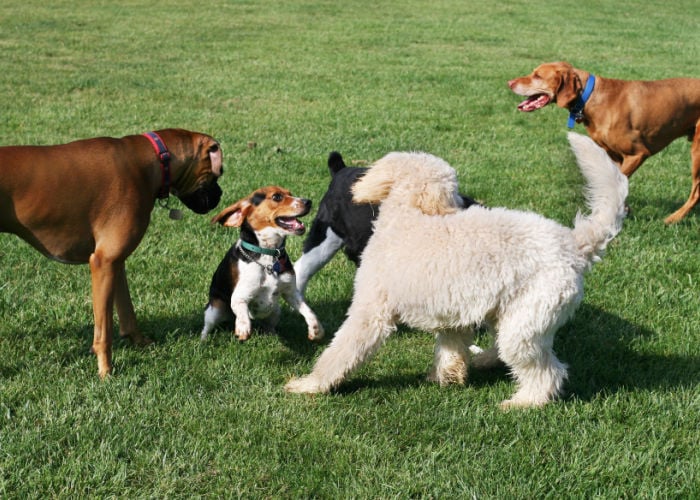
Proper Introductions Between Dogs
Dogs are naturally territorial beings and may get defensive if exposed to numerous dogs abruptly.
Proper introductions where each dog briefly sniffs and greets their animal peers effectively encourage a healthy environment between them.
This process is usually carried out before entering the off-leash area, where the dogs may be harder to control.
It’s important to monitor your dog for signs of distress and anxiety, as these may show up as aggression or other destructive behaviors later.
Dog toys or treats are an effective way of controlling their behavior.
However, we do not recommend bringing them to dog parks as they may trigger guarding behavior.
This leads to conflicts even when another dog approaches their materials out of curiosity, and dogs are natural explorers with a need to assert their own, after all!
Recognizing and Managing Signs of Stress or Discomfort
Remember when we discussed the importance of monitoring signs of fear and apprehension in your four-legged friend?
Well, while it would be ideal to show no such signals, it would also be impractical, depending on the nature and nurture of your pet.
Some dogs may be more prone to developing anxiety when out in a public environment.
This may be because of their genetic predisposition and living a relatively isolated life during their developmental years as a puppy.
Do not force your dog to interact with other pets if they seem uncomfortable or unwilling to interact with other dogs.
This may trigger their aggressive instincts, and they may lash out in other socially inappropriate ways.
The best advice would be to temporarily remove your pet from the situation and contact a professional if the condition persists.
Preventing Excessive Barking or Noise
Dogs may bark excessively for multiple reasons, including protective instincts, attention-seeking tactics, anxiety, frustration, underlying medical issues, etc.
This may disrupt the park environment and be a source of discomfort for other people and animals.
Owners should make efforts to manage and control their dog’s vocal level.
Identifying the trigger and creating a course of action that eliminates it from the root may be important.
For example, if it’s because of anxiety, the owner may initially try to take them to a park that isn’t very crowded and has minimal people.
You may also try distracting your dog and redirecting their attention someplace else.
Alternatively, temporarily removing them from the park may also help them calm down, after which you can return as you deem suitable.
Additional Regulations and Restrictions
Every park has policies depending on the park management, park size and type, visitor demographics, public input, etc.
While the previous sections were dedicated to guidelines that applied to most parks, it’s time to learn about slight variations that are still as significant when traveling with your furry friend.
You may find this information on the park website you want to visit or contact the authorities for further information.
Doing so would allow you to understand the various nuances of the recreation area and plan your trip accordingly.
So, let’s be responsible pet parents and dive into the various considerations to be entirely stress-free as we arrive at the stunning parkland!
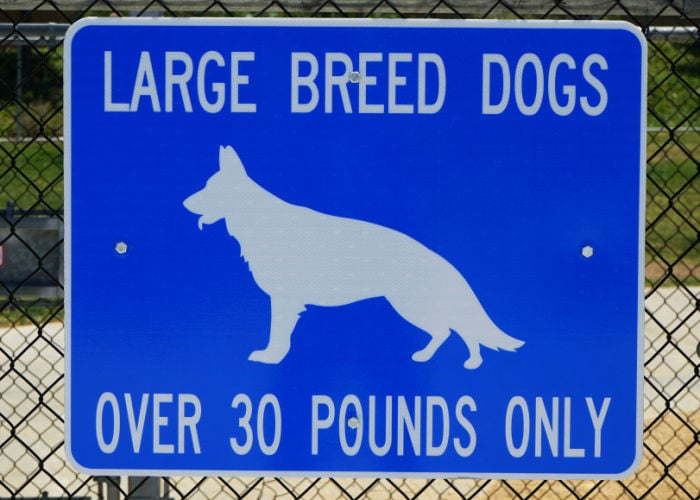
Age limits for dogs and children
Did you know there are age specifications for dogs and children at dog parks?
Some parks only allow adult dogs to ensure they will be appropriately trained and won’t disrupt the environment.
On the other hand, some parks have designated areas for small-sized dogs to ensure everyone has an equal opportunity to have fun and that no one feels left out.
Specific park hours or closures
Some parks are open all year round, while others may close during extreme winters or summer.
These places usually undergo harsh weather conditions and must be shut down to ensure public welfare.
Alternatively, some places may remain open with the closure of specific routes and places within the park.
Then, you may enjoy your visit with your canine companion with a slight reduction in the number of parks you’d be permitted to explore.
Prohibited items or activities
Parks often have a list of items you cannot bring, including glass containers, food or treats, etc.
This is to ensure no one gets accidentally harmed or injured during their stay here.
Additionally, certain eatables harm dogs or may trigger defensive and territorial behavior.
For example, an animal may be inclined to approach that provision due to its enticing scent, causing your pet to become defensive.
Avoiding all such edibles to ensure public safety and well-being is better.
Organizing events (such as dog training or management) is also forbidden without official approval from the park authorities.
Limitations on the number of dogs per person
Some people have multiple dogs and may be inclined to bring all of them.
This might be a problem as one person may fail to supervise numerous dogs at the same time adequately.
Most parks have a one-dog per-person policy to maintain control and prevent park overcrowding.
Alternatively, some may allow 2-3 dogs per person if the individual meets the criteria.
These include having your dogs leashed at all times and a proven record showing your efficacy in maintaining peace with other parks.
Dog Park Rules and Regulations: Final Words
A life lived with others is a life well-lived. Dogs need social exposure as much as humans for a sense of self-esteem.
They need to engage with creatures that are like them and learn to interact with them healthily and meaningfully.
As responsible pet parents, we must provide opportunities targeting their physical, emotional, and social needs.
All you need to do is to select a dog park known for its safety, security, and availability of amenities.
We recommend checking its online reviews to ensure that all dogs that arrive there are checked for proper vaccinations to ensure your pet is not at an increased risk of diseases through interaction with other dogs.
Once that is done, it’s time to be stress-free and have the time of your life alongside your furry friend.
You can embark on trails, let them run free in a fenced area, go to a dog-friendly swimming pool if there is any or even camp under the beautiful moonlight.
The secret to joy is living in the present and watching your pet while you’re at it. Enjoy!












